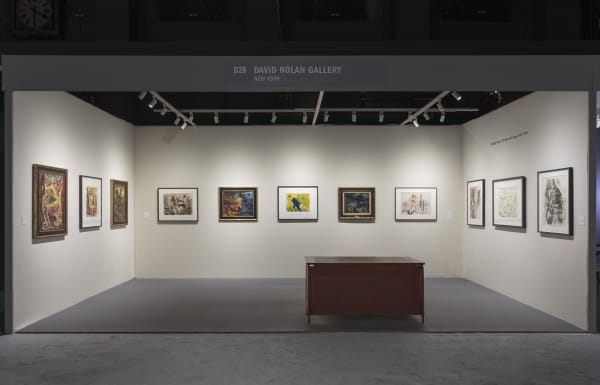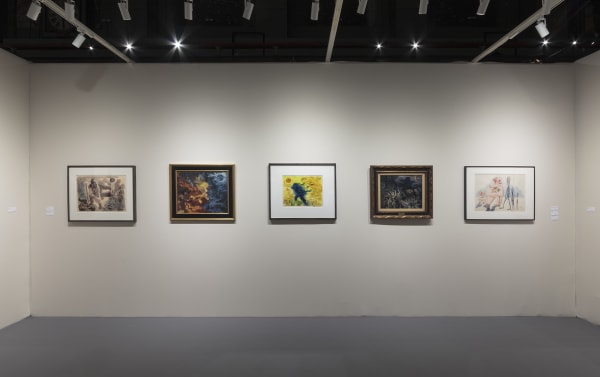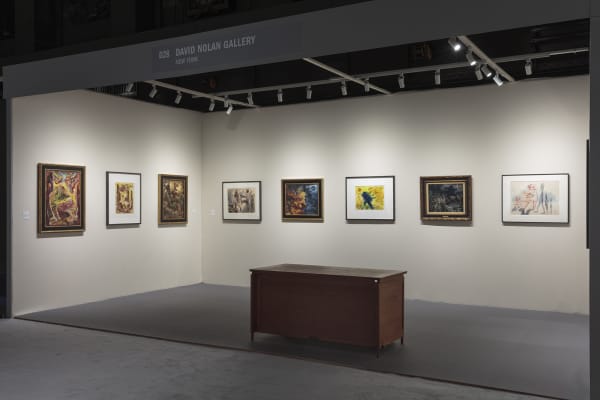For The Art Show 2019, David Nolan Gallery is pleased to present a display of works by George Grosz. Focusing primarily on significant paintings and drawings from his years in New York, the presentation will highlight the artist’s iconic images of New York City and its vicinity, which he began making shortly after his emigration to the United States in 1933.
George Grosz is one of the preeminent and enormously influential German artists of the 20th century, alongside Otto Dix and Max Beckmann. While his powerful and provocative sociopolitical work resonates across the globe, it forced him and his family to flee Berlin in 1933. Shortly before Hitler became chancellor, the offer of a teaching post at the Art Students League of New York in 1932 allowed Grosz passage to the United States. In January 1933, SA troops stormed his apartment and studio in Berlin and declared him an enemy of the state. He was stripped of his German citizenship and his assets were seized. He would spend many of his remaining years in New York, only too aware of having been dislocated from his homeland.
In New York, Grosz’s work shifted from caustic political propaganda to an allegorical commentary on human beings’ propensity for war. He was deeply disturbed by the Spanish Civil War, which he felt mirrored the atrocities in his homeland, signaling the decline of Western civilization. In 1937 his work was included in the infamous "degenerate art" exhibition that opened in Munich and traveled throughout Germany. The National Socialists took thousands of works out of German museums, including 285 works by Grosz.
Against this backdrop, Grosz offered refuge to many of his friends who had escaped Germany and its concentration camps. He made illustrations for Esquire magazine, and in 1938, received the prestigious Guggenheim award and became an American citizen. The same year his work was featured in a retrospective at the Art Institute of Chicago, and was exhibited in various American and European museums.
The seemingly a-political female nudes and drapery studies as well as landscapes composed in Cape Cod (from 1939) form a stark contrast to the tormented, allegorical landscapes Grosz produced mostly in New York at that same time, altogether forming a kind of catharsis from which he could never escape.
In 1941 Grosz began to write his autobiography, which was published in 1946. His works continued to be supported by numerous museums through exhibitions and acquisitions, including a 1941 retrospective at the Museum of Modern Art in New York, and one at the Whitney Museum in 1954. Despite this success, his career began to falter in the later 1950s with the dawn of Abstract Expressionism, when this artist’s figurative works dealing with post-war trauma had become unfashionable.
Grosz died in Berlin in 1959, shortly before his 66th birthday. His legacy is that of an artist who painted what he observed first-hand in Weimar Germany, and the looming darkness he saw coming to Europe. Many look to his work for its universal insights into challenging times, a quality that makes it particularly relevant today. His work has influenced artists like Stanley Kubrick, Andy Warhol, and James Rosenquist, and in recent years, there has been renewed interest in his work on both sides of the Atlantic by contemporary artists who collect and admire his work. Large retrospectives of the artist’s work are currently being planned in New York and Paris.
David Nolan Gallery has worked with the artist’s family and with the Estate of George Grosz (represented by Ralph Jentsch) for over 20 years and would like to thank them for supporting this presentation at the ADAA’s Art Show.







